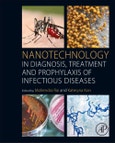This text equips readers with cutting-edge knowledge of promising developments and future prospects in nanotechnology, paying special attention to microbes that are now resistant to conventional antibiotics, a concerning problem in modern medicine.
Readers will find a thorough discussion of this new approach to infectious disease treatment, including the reasons nanotechnology presents a promising avenue for the diagnosis, treatment, and prophylaxis of infectious diseases.
Please Note: This is an On Demand product, delivery may take up to 11 working days after payment has been received.
Table of Contents
Section A: Nanotechnology in the diagnosis, treatment and prophylaxis of infectious diseases: General principles1. Gold and silver nanoparticles for diagnostics of infection
Pedro Pedrosa and Pedro V. Baptista
2. Antimicrobial models in nanotechnology, from the selection to application in the control and treatment of infectious diseases
Juan Bueno
3. Silver nanoparticles in the control of vector-borne infections
Kateryna Kon and Mahendra Rai
4. Magnetite nanostructures: Trends in anti-infectious therapy
Alexandru Mihai Grumezescu, Alina Maria Holban and Florin Iordache
5. Photodynamic therapy of infectious disease mediated by functionalized fullerenes
Michael R Hamblin and Zeyd Issa
6. Non conventional routes to silver nanoantimicrobials: technological issues, bioactivity, applications
Federica Paladini, Mauro Pollini, Alessandro Sannino, Maria Chiara Sportelli, Rosaria Anna Picca, Nicola Cioffi, Marco Valentini, Maria Angela Nitti and Antonio Valentini
7. Application of nano materials in prevention of bone and joint infections
Nusret Kose and Aydan Kose
Section B: Nanotechnology in coping with bacterial infections
8. The potency of metal nanoparticles to inhibit bacterial biofilms
Krystyna I Wolska and Katarzyna Markowska
9. Tackling the problem of tuberculosis by nanotechnology: disease, diagnosis and drug delivery
Kateryna Kon, Mahendra Rai and Avinash Ingle
10. Influence of physico-chemical properties of nanomaterials on their antibacterial applications
Vipul Bansal and Hemant Kumar Daima
11. Nanocarriers against bacterial biofilms
Noha Adel Nafee
12. Nanomaterials for antibacterial textiles
Nabil Abd El-Basset Ibrahim
13. Complexes of metal based nanoparticles with chitosan suppressing the risk of bacterial infections
René Kizek, Dagmar Chudobova, Kristyna Cihalova, Pavel Kopel, Lukas Melichar, Branislav Ruttkay-Nedecky and Vojtech Adam
Section C: Nanotechnology in coping with viral infections
14. Nanotechnology is there any hope for treatment of HIV infections or is it simply impossible?
Ranjita Shegokar
15. Nanotherapeutic approach to target HIV-1 persistence in the brain
Supriya Dinkar Mahajan, Ravikumar Aalinkeel, Jessica Reynolds, BinduKumar Nair, Stanley A Schwartz and Paras N Prasad
Section D: Nanotechnology in coping with fungal infections
16. A novel fungicidal action of silver nanoparticles: Apoptosis induction
Dong Gun Lee and Wonyoung Lee
17. Silver nanoparticles to fight Candida co-infection in oral cavity
Mariana Henriques, Douglas Roberto Monteiro, Debora Barros Barbosa, Emerson Rodrigues de Camargo, Sónia Silva, Melyssa Negri and Luiz Fernando Gorup
Section E: Nanotechnology in coping with protozoal and parasitic infections
18. Nanomedical therapeutic strategies against intracellular protozoa in the Americas
Eder Lilia Romero
Authors
Mahendra Rai Professor and Head, Department of Biotechnology, Amravati University, Amravati, Maharashtra, India.
Professor Mahendra Rai UGC-BSR Fellow is presently Visiting Professor in Department of Microbiology, Nicolaus Copernicus University, Torun, Poland. Formerly he was Headead at the Department of Biotechnology, Sant Gadge Baba Amravati University at Amravati, Maharashtra, India. He was Visiting Scientist at different Universities like University of Geneva, Switzerland, Debrecen University, University of Campinas, Brazil, Nicolaus Copernicus University, Poland. His area of expertise includes microbial biotechnology and nanobiotechnology. His present research interests are application of nanobiotechnology in medicine and agriculture, in particular, the use of metallic nanoparticles as a new generation of antimicrobials. He has published more than 450 research papers in India and abroad. In addition, he has edited/authored more than 65 books.
Kateryna Kon Associate Professor, Department of Microbiology, Virology and Immunology, Kharkiv National Medical University, Kharkiv, Ukraine.
Dr. Kateryna Kon, MD, PhD, currently works at the Department of Microbiology, Virology and Immunology at Kharkiv National Medical University, Kharkiv, Ukraine as an Associate Professor. Dr. Kon received the Best Young Scientist of Kharkiv Award in 2007. She has ten years of teaching and fifteen years of research experience. She is an editorial board member of six international peer-reviewed journals.
Dr. Kon's scientific contributions include more than 100 publications, 6 books and 18 scientific articles. The main focus of Dr. Kon's research is antibiotic resistance in bacteria, coping with microbial resistance by plant essential oils and nanoparticles, microbiology of surgical and gynaecological infections, application of different statistical methods to analysis of biomedical data.








